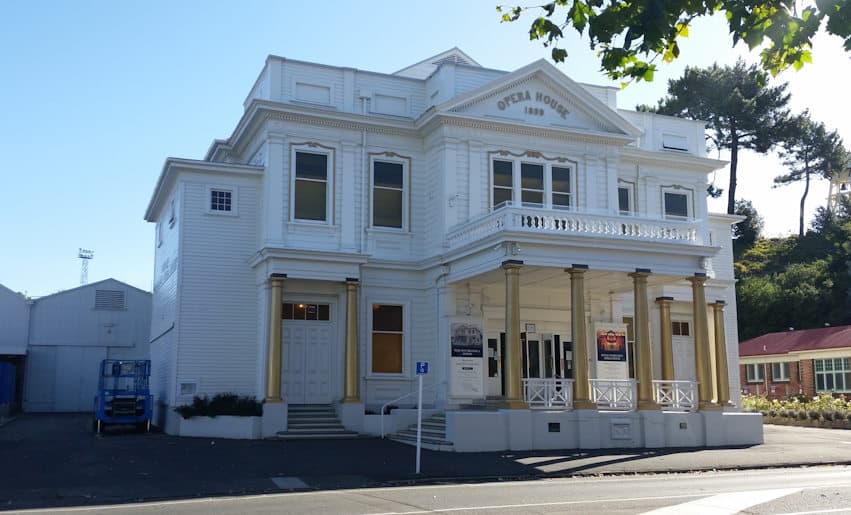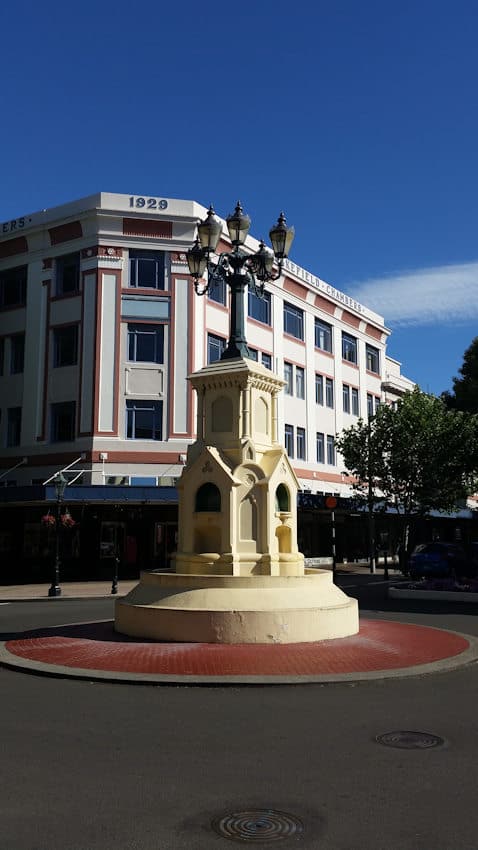One of New Zealand’s oldest cities, founded in 1840, 195 km north of Wellington and 164 km south-east of New Plymouth, near the mouth of the Whanganui River. The name means big harbour, although another version is 'long wait'; the town is known as the ‘River City’.
Whanganui is the ancestral home of Ngāti Tūpoho, Ngāti Tūmango and Ngā Paerangi, hapū (sub-tribes) of Te Āti Haunui-a-Pāpārangi. Pūtiki is the marae of Ngāti Tūpoho and Ngāti Tūmango, and Te Ao Hou at Aramoho is the Whanganui marae of Ngā Paerangi. Ngāti Tūpoho and Ngāti Rangi also have a connection with Te Ao Hou marae.
Whanganui was the New Zealand Company’s second settlement, and began as an adjunct of the first, Wellington. In the early years most European settlers came via Wellington, many by foot along the coast. The settlement was named Petre in 1842, after Lord Petre, a director of the company, but the name was never popular and was officially changed in 1854.
Uncertainty marked the early years. Lower-river Māori valued ‘their’ town but questioned the Company’s good faith. Upriver Māori were hostile, and conflict broke out in 1847. In May 1848 the government made a further payment to confirm its ownership of almost 35,000 hectares.

In the mid 1860s the town was under threat of attack by Pai Mārire adherents. Redoubts (fortifications) were built to the north-west and along the river, and troops were deployed. In late 1868 Tītokowaru’s followers from Taranaki raided farms 8 km from Whanganui, but then retreated. The 18th (Royal Irish) Regiment left in January 1870, ending a British military presence of 23 years.
Whanganui expanded in the 1870s with the European settlement of its hinterland along the coast to the north-west, and from the 1880s to 1910s as settlement spread to the inland hill country and the Waimarino plain.
Whanganui became a regional centre. Freezing works, woollen mills, phosphate works and wool stores were established in the town, and trade at the port more than doubled between 1908 and 1929.

Three landmark buildings are reminders of the vigorous community life of the era:
the old Wanganui Rowing Club building (now the Whanganui Riverboat Centre), built in 1898
the country’s oldest municipal opera house, the Royal Wanganui Opera House, built in 1899
the observatory at Cooks Gardens (a sports ground), which was built in 1903 by the astronomical society under the leadership of Joseph Thomas Ward.
Suburbs developed: Aramoho around the railway station, Whanganui East around the railway workshops, Castlecliff at the port and Gonville near the hospital and freezing works.
With the inclusion of Gonville and Castlecliff in 1924, Whanganui became a city. With a population of 24,740, it was New Zealand’s largest urban area after the four main centres. Substantial buildings at Queen’s Park underscored the new status.
Whanganui was severely affected by the 1930s depression, but thrived anew in the economically buoyant years after the Second World War. An agricultural aviation company operated out of the airport from 1950.
The urban population rose from 26,500 to just over 38,000 between 1945 and 1966. Much state (public) housing was built in the suburbs.
In 1984 the Suzuki Motor Corporation established its New Zealand headquarters in Whanganui, taking over the franchise from a firm set up in 1925 by renowned motorcycle racer Percy Coleman. Coleman’s sons Rod and Bob – both also leading motorbike racers – had expanded the business in the 1960s and 1970s.
Slow growth in the hinterland also hindered Whanganui’s growth. Some new businesses were set up, but from the mid-1980s government offices moved to Palmerston North, and many businesses downsized or closed.
The town grew economically after 1999, with diversified manufacturing and thriving tourism, focused on the river, the main street and the Queen’s Park buildings.
In 2013 Whanganui had an urban population of 38,088 – a decrease of 2% since 1966.
Article citation: Diana Beaglehole, 'Whanganui places - Whanganui', Te Ara - the Encyclopedia of New Zealand, http://www.TeAra.govt.nz/en/whanganui-places/page-1 (accessed 18 January 2021)
Story by Diana Beaglehole, published 16 Jun 2008, updated 15 Jun 2015
Aotearoa is the Maori name for New Zealand, though it seems at first to have been used for the North Island only. Many meanings have been given for the name but with Maori names the true meaning can often be found only in a mythological story or in historical fiction illustrating either how the name was given or something of the ideas which prompted it. Aotearoa is made up of either two or three words, Aotea and roa or Ao tea and roa. Aotea could be the name of one of the canoes of the great migration, the great magellan cloud near the bright star Canopus in summer, a bird or even food; ao is a cloud, dawn, daytime, or world; tea white or clear, perhaps bright, while roa means long or tall.
The most popular and authoritative meaning usually given is “long white cloud”, and there are two stories current to illustrate this. It seems the voyagers to New Zealand were guided during the day by a long white cloud and at night by a long bright cloud. The more usual one tells how, when Kupe was nearing land after his long voyage, the first sign of land was the peculiar cloud hanging over it. Kupe drew attention to it and said “Surely is a point of land”. His wife, Hine-te-aparangi, called out “He ao! He ao!” (a cloud! a cloud!) Later Kupe decided to call the land after his wife's greeting to it, and the cloud which welcomed them. The name Aotea was given both to the Great Barrier and to the North Island, but the latter became Aotearoa, presumably because of its length.
According to certain authorities, the other meanings are: big glaring light (Hochstetter); continuously clear light, or land of abiding day (Stowell); long white world (Wilson); long bright world, long daylight, long lingering day, or long bright land (Cowan); and long bright day (Tregear). A good case could probably be made out for the land of abiding day, or similar names. Maui, who is closely connected with New Zealand in mythology, once snared the sun and beat him to make him travel more slowly across the sky. Perhaps Maui achieved the same end when he sailed south to fish up New Zealand where there is longer day with long twilight, particularly in the south.
'AOTEAROA', from An Encyclopaedia of New Zealand, edited by A. H. McLintock, originally published in 1966.
Te Ara - the Encyclopedia of New Zealand
URL: http://www.TeAra.govt.nz/en/1966/aotearoa (accessed 06 Jan 2021)
With domestic travel currently the only wise activity within Covid restrictions, our local tourism industry could really do with the support so Linku2 are featuring on a number of articles to help you pick what would suit you and your family to get out and enjoy our beautiful country!
100% Pure New Zealand have some great articles to give you great ideas such as their North Island Must Do Experiences including our amazing Pouakai Crossing, stunning Cathedral Cove, Rotorua's geothermal spectacles and lots more. Check these out and enjoy every single one of them! NZ.com top North Island Activities ...